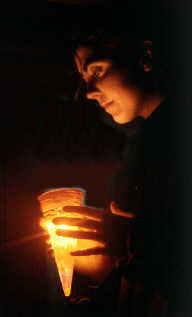But the real surprise
happened when I lit the first one in the dark workshop!
The whole shape lit up like a magic wand! It took me totally by surprise!
Here was this lovely flame floating in clear lamp oil
in a vessel coloured with colloidal silver chloride
(for a long time my basic ground colour),
and the whole thing was glowing!
Not long afterwards I was visited by a lovely lady
named Loretta, and I showed her this marvellous device.
|
 |
